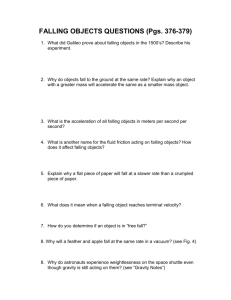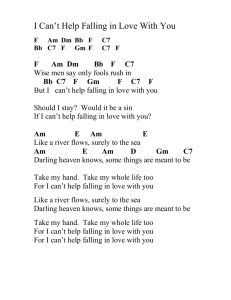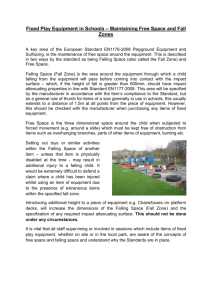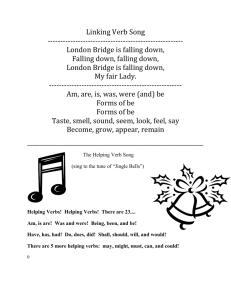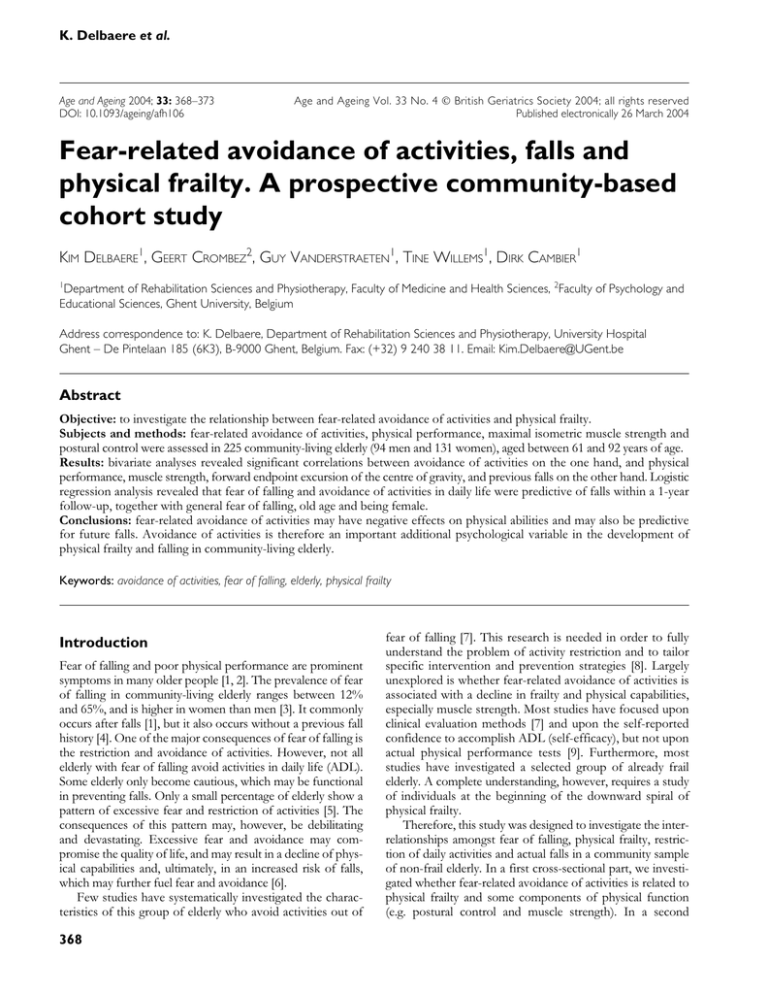
K. Delbaere et al.
Age and Ageing 2004; 33: 368–373
DOI: 10.1093/ageing/afh106
Age and Ageing Vol. 33 No. 4 British Geriatrics Society 2004; all rights reserved
Published electronically 26 March 2004
Fear-related avoidance of activities, falls and
physical frailty. A prospective community-based
cohort study
KIM DELBAERE1, GEERT CROMBEZ2, GUY VANDERSTRAETEN1, TINE WILLEMS1, DIRK CAMBIER1
1
Department of Rehabilitation Sciences and Physiotherapy, Faculty of Medicine and Health Sciences, 2Faculty of Psychology and
Educational Sciences, Ghent University, Belgium
Address correspondence to: K. Delbaere, Department of Rehabilitation Sciences and Physiotherapy, University Hospital
Ghent – De Pintelaan 185 (6K3), B-9000 Ghent, Belgium. Fax: (+32) 9 240 38 11. Email: Kim.Delbaere@UGent.be
Abstract
Objective: to investigate the relationship between fear-related avoidance of activities and physical frailty.
Subjects and methods: fear-related avoidance of activities, physical performance, maximal isometric muscle strength and
postural control were assessed in 225 community-living elderly (94 men and 131 women), aged between 61 and 92 years of age.
Results: bivariate analyses revealed significant correlations between avoidance of activities on the one hand, and physical
performance, muscle strength, forward endpoint excursion of the centre of gravity, and previous falls on the other hand. Logistic
regression analysis revealed that fear of falling and avoidance of activities in daily life were predictive of falls within a 1-year
follow-up, together with general fear of falling, old age and being female.
Conclusions: fear-related avoidance of activities may have negative effects on physical abilities and may also be predictive
for future falls. Avoidance of activities is therefore an important additional psychological variable in the development of
physical frailty and falling in community-living elderly.
Keywords: avoidance of activities, fear of falling, elderly, physical frailty
Introduction
Fear of falling and poor physical performance are prominent
symptoms in many older people [1, 2]. The prevalence of fear
of falling in community-living elderly ranges between 12%
and 65%, and is higher in women than men [3]. It commonly
occurs after falls [1], but it also occurs without a previous fall
history [4]. One of the major consequences of fear of falling is
the restriction and avoidance of activities. However, not all
elderly with fear of falling avoid activities in daily life (ADL).
Some elderly only become cautious, which may be functional
in preventing falls. Only a small percentage of elderly show a
pattern of excessive fear and restriction of activities [5]. The
consequences of this pattern may, however, be debilitating
and devastating. Excessive fear and avoidance may compromise the quality of life, and may result in a decline of physical capabilities and, ultimately, in an increased risk of falls,
which may further fuel fear and avoidance [6].
Few studies have systematically investigated the characteristics of this group of elderly who avoid activities out of
368
fear of falling [7]. This research is needed in order to fully
understand the problem of activity restriction and to tailor
specific intervention and prevention strategies [8]. Largely
unexplored is whether fear-related avoidance of activities is
associated with a decline in frailty and physical capabilities,
especially muscle strength. Most studies have focused upon
clinical evaluation methods [7] and upon the self-reported
confidence to accomplish ADL (self-efficacy), but not upon
actual physical performance tests [9]. Furthermore, most
studies have investigated a selected group of already frail
elderly. A complete understanding, however, requires a study
of individuals at the beginning of the downward spiral of
physical frailty.
Therefore, this study was designed to investigate the interrelationships amongst fear of falling, physical frailty, restriction of daily activities and actual falls in a community sample
of non-frail elderly. In a first cross-sectional part, we investigated whether fear-related avoidance of activities is related to
physical frailty and some components of physical function
(e.g. postural control and muscle strength). In a second
Activity restriction, physical frailty and falls
longitudinal part, we investigated whether fear-related avoidance of activities is a risk factor for actual falls 1 year later.
Methods
Subjects
Two hundred and twenty-five community-living elderly,
aged 60 years and older, were recruited on a voluntary basis
by mailing (response rate of 21%). All the participants were
assessed on different physical parameters in a local community
centre. Exclusion criteria for participation were (i) musculoskeletal problems such as amputation, (ii) acute or terminal
illness or (iii) prior severe central nervous system involvement. Only one participant was excluded. The study was
approved by the Ethical Board of Ghent University Hospital, and written informed consent was obtained from all
participants.
Study design
Vital statistics
In a semi-structured interview, information was obtained
about the use of pharmaceuticals and about cardiovascular,
orthopaedic or other complaints. To calculate body mass
index (BMI), body height (cm) and body weight (kg) were
recorded (BMI = weight (kg)/height (m)2).
Fall history
A fall was defined as an unintentional change in body
position resulting in contact with the ground or with
another lower level, however not as a result of a major
intrinsic event (e.g. stroke, syncope) or an overwhelming
hazard (e.g. car accident) [10]. Fall events in the past (since
the age of 60 years) were checked during the first interview
(yes or no). Fall events during the 1-year follow-up were
assessed with a ‘fall calendar’. Participants were instructed
to complete the calendar daily and to mail it at the end of
each month. They were contacted by telephone if they had
fallen during the month, if the calendar was filled in
incorrectly, or if they had forgotten to return it at the end of
the month. They were divided into three categories according
to the number of falls: no fall (non-fallers = NF); 1 fall
either in the past or during the 1-year follow-up (occasional
fallers = OF); reported falls in the past and during the
1 year of follow-up (frequent fallers = FF). The baseline
procedure was completed by 225 participants and the followup by 221 participants. Registered reasons for loss during
the 1-year follow-up were: died (n = 1), refused further
participation for personal reasons (n = 1) and physically
unable (n = 2).
Avoidance of activities
The fear-related avoidance of activities was measured using
a Dutch version of the modified Survey of Activities and
Fear of Falling in the Elderly scale (SAFFE) [11]. This scale
is the self-administered version of the SAFE scale
developed by Lachman et al. [5]. All subjects were asked to
indicate whether they would avoid some activities in daily
living because of fear of falling using a three-point scale,
ranging from never (1) to always (3). This survey contains
17 items representing five basic and instrumental ADL, nine
mobility and three social activities. We divided all items in
those three subscales for the analyses. The internal consistency is excellent (Cronbach’s α = 0.92) and the test–retest
reliability is good (0.75) [11].
Physical frailty
Physical frailty was measured using the Physical Performance
Test (PPT). This performance-based test was developed to
represent ADL with various degrees of difficulty, ranging
from ‘eating’ over ‘picking up a coin’ to ‘ascending and
descending stairs’. Each of the nine items has 0 to 4 levels
of performance, based on completion of the task and time
for completion. The intra- and inter-operator reliability are
good with Cronbach’s α of 0.87 and 0.99, respectively, and
there is good concurrent and construct validity [12].
Postural control
Impairment-based balance testing was conducted using the
Basic Balance Master system (version 8.0, NeuroCom®
International, Inc., Clackamas, USA). This force plate system
consists of two footplates connected by a pin joint. In each
plate there are two force transducers that quantify changes
in the vertical pressures applied to the support surface. The
vertical ground reaction forces are used to calculate the
position of the centre of pressure (COP) and the equivalent
centre of gravity (COG) sway angles. Multiple dimensions
of balance were assessed using the modified Clinical Test of
Sensory Interaction on Balance (m-CTSIB) and the 100%
Limits of Stability (LOS) using visual biofeedback: body
sway (°/sec), maximal and endpoint excursion of the COP
(%LOS) and directional control (%LOS). The endpoint
excursion of the COP is the initial movement to reach the
target without subsequent corrective attempts and the maximal
excursion the total movement of the COP.
Muscle performance
The maximal isometric strength in knee and ankle extensors
and flexors was measured using a hand-held dynamometer
(Microfet® 2, Hoggan Health Industries), as the peak force
expressed in newtons (N). The best performance of two
trials was selected for each side, and the averages of the left
and right extremity were used in the analyses. Each participant was asked to perform a maximal isometric contraction
of the target muscles lasting 5-second with a 1-minute rest
period between the trials. Verbal encouragement was provided. Before actual testing, they were asked to perform
three contractions without resistance in order to practise the
movement. For knee strength, the patient was seated on a
treatment table with feet unsupported and knee flexed about
45° from complete joint extension. The dynamometer was
applied 25 cm below the caput fibulae and perpendicular to
the tibial crest, with stabilisation applied just above the
369
K. Delbaere et al.
A logistic model for the prediction of falls was obtained, with
adjusted ORs of the variables with their 95% CIs.
knee. For ankle strength, the patient was tested lying on the
side to be tested on a treatment table with stabilization
applied over the lower leg. The test limb was extended at
the hip and knee, and 25° of plantar flexion at the ankle.
The hand-held dynamometer was positioned perpendicular
against the plantar or dorsal surface of the midfoot just
proximal to the metatarsal phalangeal joints [13].
The maximum grip strength of the dominant hand was
recorded with a hydraulic hand dynamometer (Baseline®,
Fabrication Enterprises, Inc., New York, USA). The subject
was seated on a chair while the tested arm was stretched out
forward. The palm and fingers were clasped around the
handle, while the subject brought his/her arm next to his/
her body in 3 seconds. The highest value of three trials,
expressed in kilograms (kg), was used in the analyses.
Results
General outcomes
The characteristics of the participants at baseline are presented in Table 1. Frequent fallers were more likely to be
female, used more medications, were physically frailer
according to the PPT, and avoided more feared activities in
comparison with OF and NF. Avoidance behaviour was
pronounced most often for mobility tasks such as walking
and reaching.
Cross-sectional outcomes
Statistics
The total SAFFE score showed a strong correlation with
falls in the past (r = 0.33; P < 0.001), with general physical
frailty (r = −0.49; P < 0.001) and also with some of its components (see Table 2). The strongest correlation for maximal strength was found with the knee extensors (r = −0.44;
P < 0.001), knee flexors (r = −0.34; P < 0.001) and hand grip
strength (r = −0.37; P < 0.001); and for postural control with
the forward endpoint excursion of the COP (r = −0.31;
P < 0.001). When taking into account the three subscales of
the SAFFE, stronger correlations were found for the Mobility
subscale of the SAFFE (−0.30 < r < −0.47; P < 0.001), in
Statistics were performed using the Statistical Package for the
Social Sciences (SPSS 10.0). Bivariate correlations on the crosssectional data were assessed to investigate the association
amongst fearful avoidance of activities on physical performance, postural control and muscle strength. Bivariate odds
ratios (OR) with their 95% confidence intervals (CI) of the
psychological variables were calculated for FF versus NF
using also the longitudinal data. Variables showing statistically
significant associations (P< 0.05) in the bivariate analysis were
entered into a forward stepwise logistic regression analysis.
Table 1. Baseline characteristics of the study group
All (n = 225)
Proportion (%)
or mean ± SD
NF (n = 107)
Proportion (%)
or mean ± SD
OF (n = 67)
Proportion (%)
or mean ± SD
FF (n = 47)
Proportion (%)
or mean ± SD
P
. . . . . . . . . . . . . . . . . . . . . . . . . . . . . . . . . . . . . . . . . . . . . . . . . . . . . . . . . . . . . . . . . . . . . . . . . . . . . . . . . . . . . . . . . . . . . . . . . . . . . . . . . . . . . . . . . . . . . . . . . . . . . . . . . . . . . . . . . . . . . . . . . . . . . . . . . . . . . . . . . . . . . . . . . . . . . . . .
Age (years)
BMI (kg/m2)
Women (%)
≥4 medications (%)
SAFFE score
ADL (%)
Mobility activities (%)
Social activities (%)
PPT score
72.0 ± 5.6
27.5 ± 4.1
58.4
20.4
22.8 ± 5.2
12.2
25.1
18.7
30.0 ± 4.1
70.5 ± 4.9
27.5 ± 3.4
42.1
15.9
21.3 ± 4.4
6.8
19.5
15.5
31.2 ± 2.6
73.9 ± 6.6
27.0 ± 4.0
65.7
17.9
23.4 ± 5.9
15.5
27.4
19.7
29.2 ± 5.2
74.9 ± 4.4
28.1 ± 4.4
85.1
34.0
25.1 ± 5.2
19.8
34.2
24.8
28.1 ± 4.1
<0.001
0.414
<0.001
0.032
<0.001
<0.001
0.001
0.133
<0.001
NF = non-fallers; OF = occasional fallers; FF = frequent fallers.
Table 2. Means, standard deviations (SD) and Spearman correlation coefficients (R) among SAFFE, falls based on retrospective
outcomes and physical outcomes
Mean
SD
2
3
4
5
6
7
8
9
. . . . . . . . . . . . . . . . . . . . . . . . . . . . . . . . . . . . . . . . . . . . . . . . . . . . . . . . . . . . . . . . . . . . . . . . . . . . . . . . . . . . . . . . . . . . . . . . . . . . . . . . . . . . . . . . . . . . . . . . . . . . . . . . . . . . . . . . . . . . . . . . . . . . . . . . . . . . . . . . . . . . . . . . . . . . . . . .
1 SAFFE
2 Falls in the past (%)
3 PPT
4 Knee extensors
5 Knee flexors
6 Hand grip strength
7 F-COP
8 Functional reach
9 Timed chair-stands
a
P < 0.001.
Pearson’s correlations.
c
Spearman’s rho correlations.
b
370
22.8
35.0
30.0
216.3
140.5
36.9
55.2
33.5
13.2
5.2
–
4.1
77.4
50.8
10.5
21.2
7.5
5.2
0.33
–
–
–
–
–
–
–
–
ac
−0.49
−0.42ab
–
–
–
–
–
–
–
ab
−0.44
−0.36ab
0.48ab
–
–
–
–
–
–
ab
−0.34
−0.35ab
0.40ab
0.82ab
–
–
–
–
–
ab
−0.37
−0.41ab
0.37ab
0.63ab
0.56ab
–
–
–
–
ab
−0.31
−0.22ab
0.41ab
0.30ab
0.24ab
0.28ab
–
–
–
ab
−0.36
−0.28ab
0.45ab
0.41ab
0.40ab
0.50ab
0.32ab
–
–
ab
−0.41ab
0.31ab
−0.47ab
−0.25ab
−0.15ab
−0.19ab
−0.26ab
−0.18ab
–
Activity restriction, physical frailty and falls
comparison with the ADL subscale (−0.25 < r < −0.41;
P< 0.001) and in comparison with the Social Activity subscale
of the SAFFE (−0.17 < r < −0.30; P < 0.001).
Longitudinal outcomes
The SAFFE showed a strong correlation with fall incidence
after the follow-up (r = 0.30; P < 0.001). The contribution of
the psychological variable in predicting falls 1 year later was
investigated using a binary logistic regression analysis.
Participants were classified in two groups according to the
self-reported falls during the follow-up period (FF, 20.9%
versus NF, 47.6%). Table 3 summarises the results of these
analyses. It shows that the one-item fear of falling and the
ADL and Mobility subscales of the SAFFE are significantly
associated with falls. Table 4 presents the risk model for the
prediction of falls as a result of a stepwise logistic regression
analysis. The ADL subscale of the SAFFE and the one-item
fear of falling were found to be the best psychological
predictors of falls. When age and gender were added, the
predictive ability of the model improved. The function (1) of
the best fitting model is:
g(x) = −12.37 + 0.11 (age) + 1.21 (gender)
+ 0.20 (ADL) + 2.51 (fear)
(1)
After logit transformation (2), this model predicts the risk
of future falls due to fear of falling.
g(x )
e
Π ( x ) = -------------------g( x)
1+ e
(2)
The outcome ranges between 0 and 1 and can therefore be
interpreted as a percentage, where 0 represents no risk for
falling and 1 the highest possible risk of falling.
Discussion
The present study is one of the first studies that investigated
the interrelationship of fear-related avoidance of activities
Table 3. Odds ratios of different variables for frequent falls
(n = 47) versus no falls (n = 107) after 1 year follow-up
OR
P
95% CI
. . . . . . . . . . . . . . . . . . . . . . . . . . . . . . . . . . . . . . . . . . . . . . . . . . . . . . . . . . . . . . . . . . . . . . . . . . . . . . . . . . . . .
Age
Gender (F)
SAFFE
ADL
Mobility activities
Social activities
One-item fear of falling (yes)
<0.001
<0.001
<0.001
<0.001
0.001
0.086
<0.001
1.11
3.86
1.12
1.38
1.12
1.16
2.83
1.05–1.18
2.12–6.80
1.05–1.18
1.16–1.65
1.05–1.20
0.98–1.38
1.78–4.52
with actual physical performance and with the incidence of
falls in a sample of community-living elderly. The rate of falls
in the past (35%) and during the 1-year follow-up (33.5%)
reported in our sample are comparable with previous reports
[14]. Our results can be readily summarised: (i) mobility tasks,
including reaching and walking, were avoided the most by
elderly with fear of falling; (ii) fear-related activity restriction
is correlated with physical performance, forward excursion of
the COP and maximal muscle strength; (iii) fear of falling and
restriction of ADL predict falls during a 1-year follow-up.
Fear-related avoidance of activities and
physical frailty
When people withdraw from ADL and outdoor social
contact, they become more susceptible to the negative effects
of social isolation and physical inactivity [6, 7]. Avoidance
also increases loss of muscle strength and postural control
[2]. Our results replicate and extend this view: we found
substantial evidence for the association between avoidance
of feared activities on the one hand and physical performance, muscle strength and postural performance on the
other hand. These associations were most pronounced for
mobility activities such as walking and reaching, and less
pronounced for ADL and social activities. It is possible that
our community-living elderly still had sufficient functions to
manage basic ADL and social activities. Some data from our
semi-structured interview are in line with this view: the elderly often reported that family or friends came to pick them
up for social activities.
Our results corroborate the idea that fear of falling and
avoidance are important variables in the transition to physical frailty. The more activities that the elderly avoid, the
more difficulties they experience in doing these activities. It
is possible that avoidance of activities dramatically speeds
up the process of physical frailty because of the devastating
consequences of physical inactivity [15].
Avoidance of feared activities was not only related to the
general status of physical frailty, but also to some specific
components of physical function, including less muscle
strength in the knee, less hand grip strength and less forward excursion of the COP. Because the elderly who avoid
feared activities have decreased muscle strength, it is likely
that they will experience limitations during activities such as
shopping, going for a walk, walking around indoors and
bending down to pick something up. This may further
increase their feelings of insecurity and apprehension. Fear
of falling was also related to the endpoint excursion of the
COP in the forward direction on the Basic Balance Master®.
Table 4. Risk model for the prediction of falls versus no falls obtained by binary logistic regression (n = 221)
B
SE
P
OR
95% CI
. . . . . . . . . . . . . . . . . . . . . . . . . . . . . . . . . . . . . . . . . . . . . . . . . . . . . . . . . . . . . . . . . . . . . . . . . . . . . . . . . . . . . . . . . . . . . . . . . . . . . . . . . . . . . . . . . . . . . . . . . . . . . . . . . . . . . . . . . . . . . . . . . . . . . . . . . . . . . . . . . . . . . . . . . . . . . . . .
Age
Gender (F)
SAFFE score (subscale ADL)
One-item fear of falling (yes)
Constant
0.11
1.21
0.20
2.51
−12.37
0.03
0.32
0.09
1.06
<0.001
<0.001
0.038
0.017
1.11
3.36
1.22
12.33
1.05–1.18
1.79–6.29
1.01–1.46
1.56–97.54
B = regression coefficient; SE = standard error; (F) = female.
371
K. Delbaere et al.
A potential explanation for this association may be found in
the contextual characteristics of the LOS test. During this
test, participants saw the ground or the wall approaching
towards them. Because most functional tasks (e.g. walking)
consist of a forward displacement of the COG, a decreased
forward excursion of the COP can cause a decreased stride
length in gait as a stabilising adaptation related to fear of
falling [16]. A possible reason for the absence of a correlation
between SAFFE and directional control, and between SAFFE
and the maximal excursion of the COP in the forward direction, is that elderly who avoid feared activities probably lean
forward to the point where they still feel confident and then
start to move carefully to the target in order to keep control
over their COG.
Figure 1. Vicious circle of frailty.
Fear-related avoidance of activities and falls
Both in the cross-sectional part and in the longitudinal part
falls were associated with avoidance of activities. Although it
is reasonable to assume that a fall precedes a pattern of fear
and avoidance, several studies have pointed out that this is
not necessarily the case for everybody [4, 17]. It is our opinion
that some elderly indeed fear falling without a fall history,
but that avoidance of feared activities is primary caused by
an actual fall. One fall can so trigger a serious downhill spiral
of disability through avoidance of feared activities.
Our prospective study also yielded a survey of psychological risk factors for falls and a risk model for the prediction of falls due to fear of falling, consisting of variables
easy to assess in general practice. General fear of falling and
avoiding ADL are the best psychological predictors of falls,
especially in combination with old age and being female.
Although mobility activities showed the best correlation
with physical performance and falls, avoidance of ADL was
the strongest predictor of falling. An interesting hypothesis
for these findings may be the gradual expansion and exacerbation of avoidance behaviour at the mobility level, which
in the long term results in a deterioration of physical abilities
and in falls at home. More specifically, avoidance probably
starts at the mobility level, and results in the elderly becoming
afraid of going outside to unknown places. As a consequence,
they stay more and more at home. When fall incidents (e.g.
stumbling over a carpet) occur at home, they also become
fearful of activities at home. The strong reduction of physical
activity leads to a further deterioration of their physical
capabilities and their confidence in their performance of
ADL. The association between falls and avoidance of ADL
may have important implications for primary fall prevention
strategies, meaning that intervention should focus on increasing the activity level of older adults with a fear of falling in
all functional activities.
Relevance and future research
The correlation of SAFFE with the PPT, muscle strength
and excursion of the COP, which are known contributors
to physical frailty and falls [18, 19], suggests that fear-related
avoidance is an important psychosocial variable in the development and/or exacerbation of the physical frailty process.
Fear of falling may increase the risk of falling. As a consequence the elderly may avoid more activities (SAFFE), may
372
have more difficulties in performing activities of daily living
(PPT), and may be less able to use and exercise their abilities
of muscular strength and postural control. This pattern may
further fuel fear and avoidance, and may, in the long term,
lead to a further deterioration of physical performance and
an increased risk of falls (Figure 1). Individual physical
intervention, focusing on functionality, may reverse the
downward spiral of physical frailty, as a better physical function
optimises a better postural control [20], and the incidence
of unnecessary life-threatening falls may be decreased. Training of the basic physical ingredients such as balance and
muscle strength may directly affect physical frailty. It may
also reduce avoidance by increasing self-esteem and confidence in one’s own abilities to perform physical activities.
Further research however is needed to elaborate these ideas
and to assess the effects of specific intervention programmes on functional abilities in individuals with a high
fear of falling.
Conclusion
Falls and fear of falling are common and important problems
in older community-dwelling adults. One of the major consequences of fear of falling is avoidance of activities, which in
the long term may have negative effects on physical abilities.
Fear-related activity restriction was correlated with physical
performance, forward excursion of the COP and maximal
muscle strength in both knee and hand grip muscles. Elderly
with fear of falling avoided mobility tasks most often, such as
reaching and walking. Restriction of ADL activities, however,
was the best psychological predictor of falls together with
general fear of falling, old age and being female. Our findings
may be helpful in designing a screening instrument for the
elderly at risk for falls and of becoming physically frail. Future
research should investigate whether individualised intervention
strategies are efficient in preventing falls and activity-related
fear of falling within this population.
Key points
• Mobility tasks, such as walking and reaching, are most
often avoided by the elderly with fear of falling.
Activity restriction, physical frailty and falls
• Fear-related avoidance of activities is correlated to physical
performance, including general physical frailty, postural
control and maximal muscle strength.
• Fear-related avoidance of activities is predictive of future
falls.
Acknowledgements
The authors thank the individuals who volunteered for the
study and also the following contributors to the data collection
are gratefully acknowledged: B. Cagnie, N. Debel, M. De
Coninck, K. Decoussemaeker, A. Serck, F. Sinnaeve, E. Vinck
and L. Wauters.
References
1. Tinetti ME, Medes de Leon CF, Doucette JT, Baker DI. Fear
of falling and fall-related efficacy in relationship to functioning
among community-living elders. J Gerontol Med Sci 1994; 49:
M140–7.
2. Kressig RW, Wolf SL, Sattin RW et al. Associations of demographic, functional and behavioral characteristics with activityrelated fear of falling among older adults transitioning to
frailty. J Am Geriatr Soc 2001; 49: 1456–62.
3. Legters K. Fear of falling. Phys Ther 2002; 82: 264–72.
4. Vellas BJ, Wayne SJ, Pomero LJ, Baumgartner RN, Garry PJ.
Fear of falling and restriction of mobility in elderly fallers. Age
Ageing 1997; 26: 189–93.
5. Lachman ME, Howland J, Tennstedt S, Jette A, Assmann S,
Peterson EW. Fear of falling and activity restriction: The
Survey of Activities and Fear of falling in the Elderly (SAFE).
J Gerontol Psych Sci 1998; 53B: P43–50.
6. Arfken CL, Lach HW, Birge SJ, Miller JP. The prevalence and
correlates of fear of falling in elderly persons living in the
community. Am J Public Health 1994; 84: 565–70.
7. Murphy SL, Williams CS, Gill TM. Characteristics associated
with fear of falling and activity restriction in community-living
older persons. J Am Geriatr Soc 2002; 50: 516–20.
8. Hammerman D. Toward an understanding of frailty. Ann
Intern Med 1999; 130: 945–50.
9. Maki BE, Holliday PJ, Topper AK. Fear of falling and postural performance in elderly. J Gerontol Med Sci 1991; 46:
M123–31.
10. Tinetti ME, Speechley M, Ginter SF. Risk factor for falls
among elderly persons living in the community. N Engl J Med
1988; 319: 1701–7.
11. Yardley L, Smith H. A prospective study of the relationship
between feared consequences of falling and avoidance of activity
in community-living older people. Gerontology 2002; 42: 17–23.
12. Reuben DB, Siu AL. An objective measure of physical function
of elderly outpatients: The Physical Performance Test. J Am
Geriatr Soc 1990; 38: 1105–12.
13. Soderberg GL. Handheld dynamometry for muscle testing. In
Reese NB ed. Muscle and Sensory Testing. Philadelphia, PA:
WB Saunders Co., 1998; 378–414.
14. Masud T, Morris RO. Epidemiology of falls. Age Ageing 2001;
30 (Suppl 4): 3–7.
15. McAuley A, Mihalko SL, Rosengren K. Self-efficacy and
balance correlates of fear of falling in the elderly. J Aging Phys
Act 1997; 5: 329–40.
16. Maki BE. Gait changes in older adults: Predictors of falls or
indicators of fear? J Am Geriatr Soc 1997; 45: 313–20.
17. Friedman SM, Munoz B, West SK, Rubin GS, Fried LP. Falls
and fear of falling: Which comes first? A longitudinal prediction model suggests strategies for primary and secondary
prevention. J Am Geriatr Soc 2002; 50: 1329–35.
18. Brown M, Sinacore DR, Binder EF, Kohrt WM. Physical and
performance measures for the identification of mild to moderate frailty. J Gerontol Med Sci 2000; 55A: M350–5.
19. Ho LS, Williams HG, Hardwick AW. Discriminating characteristics of community-dwelling elderly at high and low risk for
frailty. J Aging Phys Act 2002; 10: 413–31.
20. Wolfson L, Judge J, Whipple R, King M. Strength is a major
factor in balance, gait, and the occurrence of falls. J Gerontol
1995; 54A (Special Issue): 64–7.
Received 2 September 2003; accepted in revised form 14 January 2004
373


